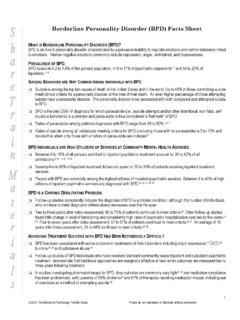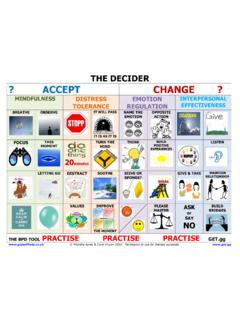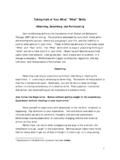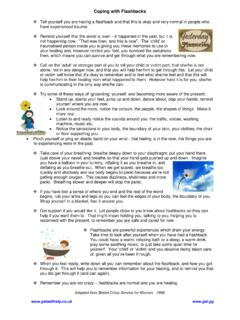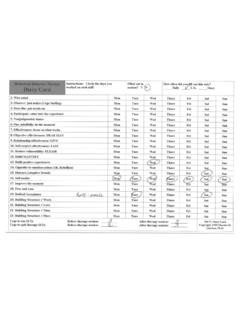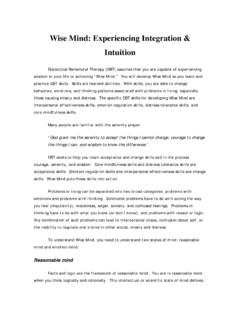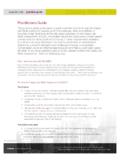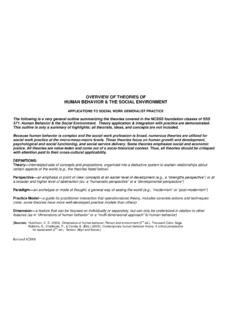Transcription of Mindfulness for clients and family members w-o …
1 Mindfulness for clients , their Friends, and family members Cindy Sanderson, Introduction and Welcome. The description of Mindfulness that follows is for anyone interested in the topic, although it s written mainly for those of you brand new to the concept. It s drawn from the work of Marsha Linehan, , the psychologist who developed DBT. When you read things in quotation marks, they are her words verbatim. Dr. Linehan is among several prominent therapist-researchers who are integrating Mindfulness skills with other standard ways of doing therapy. They all are working to create new and more effective ways to help people. While Dr. Linehan s ideas are what I ll be discussing below, I want to acknowledge, as she would, that she has drawn on the work of many other people and reads widely on the research being conducted on Mindfulness .
2 She practices what she preaches , meaning, she practices Mindfulness , as do I and the majority of therapists who teach DBT. My way of teaching Mindfulness is to write or talk a bit about it and then give plenty of examples. I hope you ll find this way of teaching helpful. Whatever your opinion, I d be grateful for feedback on whether or not you found this page helpful. I hope you ll write me my email address to let me know what you think. A Definition of Mindfulness . Mindfulness is awareness without judgment of what is, via direct and immediate experience . You re being mindful when you eat dessert and notice every flavor you are tasting, instead of eating the dessert while having a conversation and looking around the room to see who you know. If you re being mindful, you re not thinking about is it good or bad to have dessert?
3 You re just really having dessert. having gotten free of your anxiety or self-consciousness, you dance to music and experience every note, instead of wondering if you look graceful or foolish. thinking about someone you love or someone you hate, you pay attention to exactly what your love or your hate feels like. You re not caught up in justifying the love or hate to yourself; you re just diving into the experience, with full awareness that you re diving in. you walk through a park, you actually walk through the park. What does that mean? It means you let yourself show up in the park. You walk through the park aware of your feelings about the park, or your thoughts about the park, or how the park looks, or the sensation of each foot striking the pavement. This is different than taking a walk in the park and not showing up instead, walking through the park while you are distracted by thoughts of what you ll have for lunch, or the feelings towards a friend with whom you just argued, or worries about how you re going to pay this month s bills.
4 If you stop to think about it, you ll realize that very few of us devote ourselves to living mindfully, meeting each moment of life as it presents itself, with full awareness, letting our judgments fall away. Instead, we do things automatically, without noticing what we re doing. We churn out judgments about ourselves and others. We regularly do two or three or five things at once. We frequently get so caught up in our thoughts and feelings about the past or future that we re lost in them, disconnecting from what is happening right now in front of us. There are lots of rewards for living this way--we can get a lot done quickly, think of ourselves as efficient, and be seen by the world as productive and smart. In highly industrial or technological societies, a high value is placed on doing a lot at once.
5 In fact, people sometimes make fun of each other by saying, What s wrong with you? Can t you do two things at once? We also live without awareness because sometimes living with full awareness is very painful. We avoid painful thoughts, feelings, and situations when we are afraid or angry or ashamed or sad because we re convinced that we can t do anything to change them AND because we re convinced we can t stand to live with them. For instance, have you ever avoided bringing up a problem in a relationship with someone because you re afraid the person will get mad at you, attack you, or leave you? You keep avoiding bringing up the problem because you feel so scared. So, you get yourself off the fear hook temporarily by not talking it over. In the meantime, you re ashamed of yourself for not speaking up.
6 You get more and more annoyed with the other person. You try to ignore what he or she does that bothers you, but the problem gets worse and worse. Finally you just give up, letting the relationship end. Maybe the problem could have been solved; maybe not. But there s an important distinction to make between the unavoidable pain of having a problem with a person you love versus the suffering you cause yourself by letting fear control you, judging yourself for feeling afraid, assuming nothing you d try would work instead of trying out solutions, feeling guilty about feeling anger towards someone you love, or judging the person for causing the problem. There s so many ways Mindfulness could help with the above example, it s hard to know where to start. Because of limited time and space, I ll only discuss a few.
7 1 - You could use Mindfulness skills and bring your full attention to the feelings of annoyance, instead of pushing them away or trying to talk yourself out of them. Maybe you re afraid you can t stand to feel annoyed, but actually, watching how you feel inside, you realize, hey, it s just annoyance for 10 minutes and I CAN stand it . 2- You could use Mindfulness to become a great detective and notice exactly how and when you feel annoyed. Maybe it s when he or she has had three cups of coffee before seeing you; maybe it s when both of you are tired; and, maybe it s when he or she s had a bad day at work. In this way, you use awareness to get specific and clear about what contributes to the problem. The more specific you get about what goes into the problem, the better chance you have to solve it.
8 Ask her to drink less coffee or switch to decaffeinated coffee; make plans to get together when you re both rested; don t meet on bad work days. 3- You could use your Mindfulness skills to watch how your mind generates thoughts like It shouldn t be this way; why can t we just get along! Real friends don t have problems . Listening in on your thoughts, you realize that your expectations don t fit with reality, so you work on changing your expectations. 4- You could use Mindfulness skills, as you talk through the problem with your friend, to bring your full and open awareness to whether or not you experience your friend listening to and understanding you or defending herself and criticizing you. If she s really listening and caring, you might notice relief inside and decide to keep working with her on the problems in the friendship.
9 On the other had, if you notice that she is dismissive or non-responsive each time you talk about a problem, you might notice that you are sad and disappointed but not willing to put more energy into a friendship that makes you unhappy. To summarize, Mindfulness is awareness, without judgment, of life as it is, yourself as you are, other people as they are, in the here and now, via direct and immediate experience. When you are mindful, you are awake to life on its terms fully alive to each moment as it arrives, as it is, and as it ends. Of course, in order to build and maintain Mindfulness requires specific skills that are practiced over and over. That s what comes next. How and Why to Practice Mindfulness . Mindfulness is a skill that can be learned like any other. There is nothing mysterious about it.
10 It s like learning to ride a bike or cook good meals or paint with watercolors or play a musical instrument. You start with easy practice and progress to harder practice. You take classes in it from people who know more about it than you do. You make friends with other people who are interested in it so you have a built in support group to keep you going when you get discouraged. Sometimes you ll feel like you re making a lot of progress; other times you ll be discouraged. But, it is certain that if you practice, practice, practice, your skill at Mindfulness will improve. So what s the practice? The practice of Mindfulness is the repetitive act of directing attention to only one thing in this one moment . And if you are brand new to Mindfulness , you may respond with either I can already do that or Why on earth would I do that?
